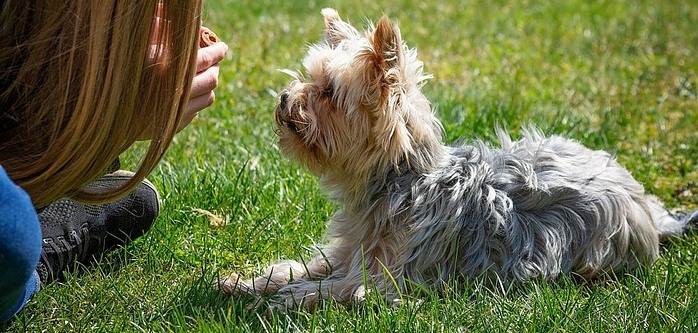Clicker training has gained widespread popularity as a highly effective and humane method for training dogs. This positive reinforcement technique utilizes a small handheld device known as a clicker, paired with treats or rewards, to communicate and reinforce desired behaviours in dogs. In this article, we will explore the principles behind clicker training, its advantages, and how to implement this rewarding approach to enhance the bond between you and your furry friend.
Understanding Clicker Training:
Clicker training is based on the principles of operant conditioning, a learning process that involves associating a behaviour with its consequences. In this case, the clicker serves as a precise and consistent marker to indicate the exact moment your dog performs the desired behaviour. The click is followed by a treat or reward, reinforcing the positive behaviour and increasing the likelihood of its repetition.

Advantages of Clicker Training:
1. Precision and Timing:
Clicker training allows for pinpoint accuracy in marking desired behaviours. The distinct sound of the click provides immediate feedback to the dog, helping them understand precisely which action earned them a reward. This precision in timing accelerates the learning process.
2. Clear Communication:
Dogs are highly responsive to clear and consistent communication. The clicker serves as a universal signal that is distinct from verbal cues, making it easier for your dog to understand and respond to the training.
3. Positive Reinforcement:
Clicker training is centred around positive reinforcement, creating a positive association between the desired behaviour and the reward. This approach promotes a positive learning experience, fostering a strong bond between you and your dog.
4. Versatility:
Clicker training can be applied to teach a wide range of behaviours, from basic commands like sit and stay to more complex tricks. Its versatility makes it suitable for dogs of all ages and breeds, catering to various training needs.

Implementing Clicker Training:
1. Acquainting Your Dog with the Clicker:
Start by associating the clicker with positive experiences. Click and immediately reward your dog with a treat several times, allowing them to understand that the sound of the click predicts a treat.
2. Marking Desired Behaviours:
Once your dog associates the click with a reward, use it to mark specific behaviours you want to reinforce. Click the moment your dog performs the desired action, followed by a treat.
3. Consistency is Key:
Consistency is crucial in clicker training. Be consistent in the timing of your clicks and rewards to avoid confusion. Reinforce the behaviour each time it occurs, gradually phasing out treats as the behaviour becomes more ingrained.
4. Short, Positive Sessions:
Keep training sessions short and enjoyable for your dog. Aim for multiple short sessions throughout the day, focusing on one or two behaviours at a time. This approach keeps the training experience positive and prevents your dog from becoming bored or fatigued.
Conclusion:
Clicker training is a powerful and positive method that can transform the way you communicate with your canine companion. By leveraging the principles of positive reinforcement and clear communication, clicker training fosters a strong bond between you and your dog while achieving desired behaviours. With patience, consistency, and a pocketful of treats, you can embark on a rewarding journey of training and building a lifelong connection with your furry friend.
XLDB loves saving money so I always try to plan ahead and watch for big sales at times of the year like Black Friday, Cyber Monday and Boxing Day. Major discounts can also be found after the related season comes to a close and I always recommend keeping an eye out for Amazon Prime Day Deals as those can offer big savings too!
As an Amazon Associate I earn from qualifying purchases.